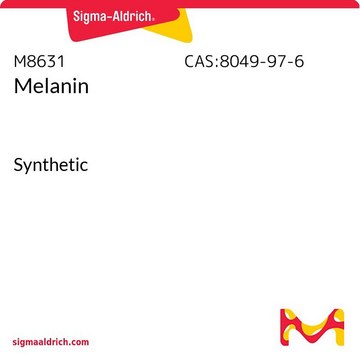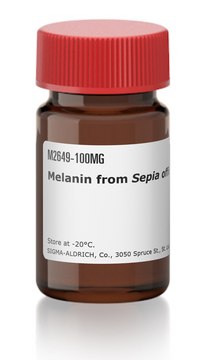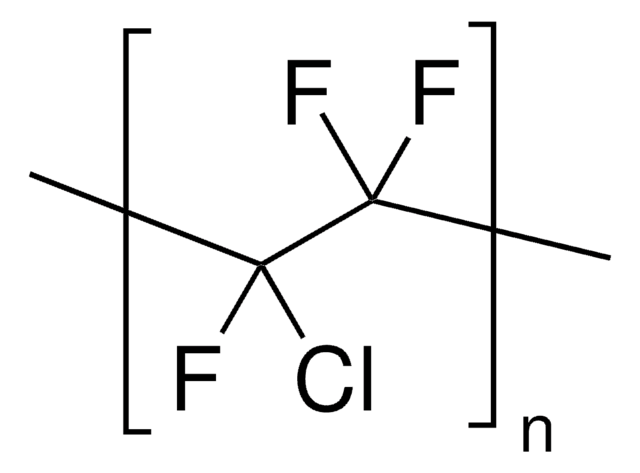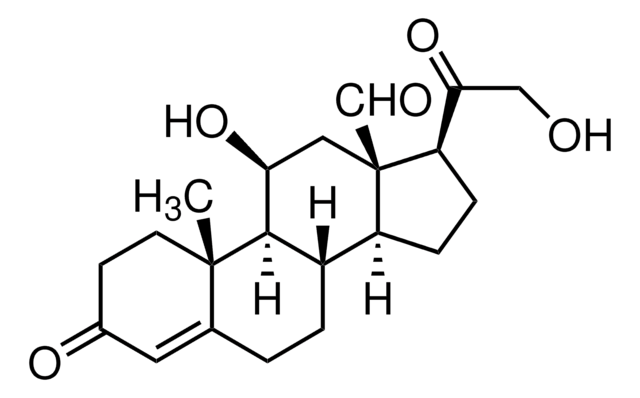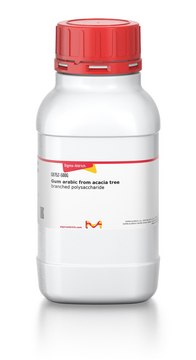M0418
Melanin
BioReagent, Synthetic, suitable for cell culture
Sign Into View Organizational & Contract Pricing
All Photos(1)
About This Item
Recommended Products
biological source
synthetic
product line
BioReagent
Assay
≥97% (TLC)
form
powder
technique(s)
cell culture | mammalian: suitable
solubility
1 N NH4OH: 20 mg/mL
storage temp.
−20°C
SMILES string
[nH]1c2c3c(c4c5c([nH]c4)c([c]([c](c5c3c1)=O)=O)C)[c]([c](c2C)=O)=O
InChI
1S/C18H10N2O4/c1-5-13-9-7(3-19-13)12-10-8(11(9)17(23)15(5)21)4-20-14(10)6(2)16(22)18(12)24/h3-4,19-20H,1-2H3
InChI key
XUMBMVFBXHLACL-UHFFFAOYSA-N
Looking for similar products? Visit Product Comparison Guide
General description
Melanin is a distinctive class of pigment found in animals, plants, bacteria, and fungi. It is an amorphous polymer formed by the polymerization of phenolic and indolic compounds.
Application
Melanin has been used:
- to incubate normal human keratinocytes for Masson-Fontana staining
- as a standard in the determination of melanin content in normal human epidermal melanocytes and immortalized human keratinocytes
- as an absorber to mimic human skin or melanocytic nevi and melanoma
Biochem/physiol Actions
Melanin plays a role in camouflage and energy harvesting. It also helps in protection against ionizing UV radiations, protection against biotic factors such as host defense against pathogens, and abiotic factors like heat, cold and osmotic stress. Melanin acts as a potent cation chelator and is a component of several photoprotective creams as it facilitates free radical scavenging activity. Melanin may be useful as a photo protectant in cell culture.
Preparation Note
Prepared by oxidation of tyrosine with hydrogen peroxide.
Storage Class Code
11 - Combustible Solids
WGK
WGK 1
Flash Point(F)
Not applicable
Flash Point(C)
Not applicable
Personal Protective Equipment
dust mask type N95 (US), Eyeshields, Gloves
Choose from one of the most recent versions:
Already Own This Product?
Find documentation for the products that you have recently purchased in the Document Library.
Nadine Santana-Magal et al.
Cancer research, 80(10), 1942-1956 (2020-03-05)
The recent success of checkpoint blockade therapies has established immunotherapy as one of the most promising treatments for melanoma. Nonetheless, a complete curative response following immunotherapy is observed only in a fraction of patients. To identify what factors limit the
Michael Waisberg et al.
PloS one, 7(1), e29493-e29493 (2012-01-14)
Malaria has had the largest impact of any infectious disease on shaping the human genome, exerting enormous selective pressure on genes that improve survival in severe malaria infections. Modern humans originated in Africa and lost skin melanization as they migrated
Naira V Margaryan et al.
International journal of molecular sciences, 17(3), 418-418 (2016-03-25)
Expression of Nodal, a Transforming Growth Factor-beta (TGF-β) related growth factor, is associated with aggressive melanoma. Nodal expression in adult dysplastic nevi may predict the development of aggressive melanoma in some patients. A subset of pediatric patients diagnosed with giant
Li Ni-Komatsu et al.
Molecular pharmacology, 74(6), 1576-1586 (2008-09-20)
A series of quinolines, including chloroquine and quinine, were identified as potent pigmentation inhibitors through screening a compound library in murine melanocytes. Structure-activity relationship analysis indicated that 4-substituted amino groups with a tertiary amine side chain, such as chloroquine, were
Our team of scientists has experience in all areas of research including Life Science, Material Science, Chemical Synthesis, Chromatography, Analytical and many others.
Contact Technical Service